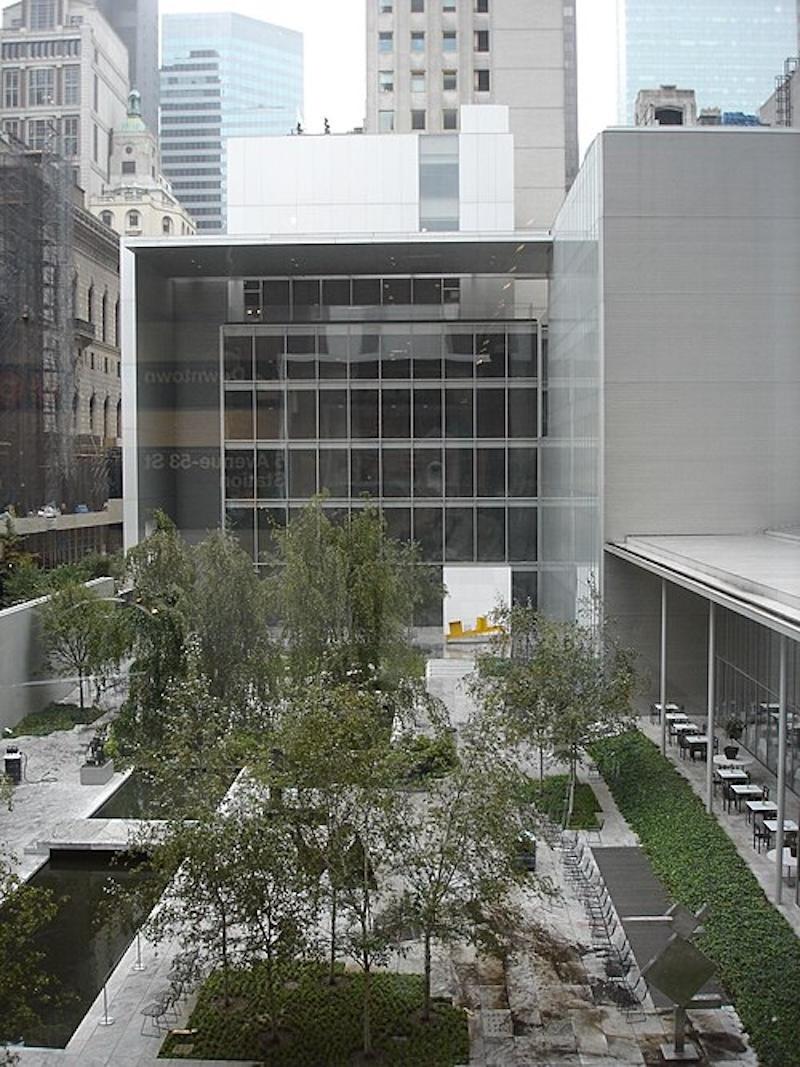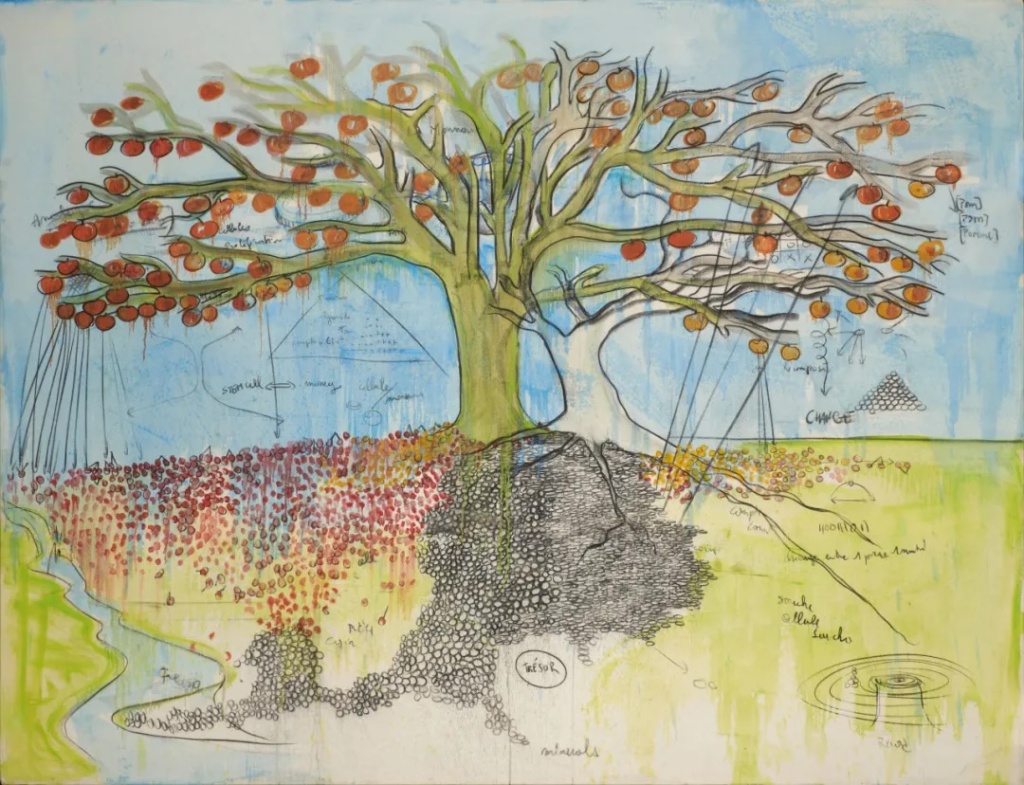
Review of this week's art figures: The Museum of Modern Art (MoMA) in New York announced that it has appointed Christophe Cherix as its next director, who will officially take office in September this year. Well-known fashion designer Guo Pei and Guangzhou Zhijincai porcelain national intangible cultural heritage inheritor Tan Guanghui jointly presented the specially commissioned work "Glass Beads" in Hong Kong; artist Dai Ying was recently invited by the Hong Kong Art Central Art Fair to participate in the "Alien Sculpture and Installation Art Project"; in Shenzhen, Xue Song's large-scale solo exhibition "Natural-Non-Natural" brings together his nearly 40 years of artistic creation; in Shanghai, Lu Rongbing's calligraphy and painting exhibition was exhibited in Minhang.
New York|Christopher Sherricks
Will become director of the Museum of Modern Art (MoMA) in New York
The Museum of Modern Art (MoMA) in New York has announced the appointment of Christophe Cherix as its next director, succeeding Glenn D. Lowry, who has led the institution for thirty years. Cherix has served as chief curator of MoMA’s prints and drawings department since 2013 and will officially take office in September this year, becoming the seventh director in MoMA’s nearly 100-year history.

Christopher Sherricks
“MoMA has a long history of embracing new forms of expression, amplifying the voices of artists from around the globe, and engaging the broadest audiences possible,” Sherricks said in a statement. “As the museum approaches its centennial, my priority is to support its exceptional staff and ensure they continue to thrive in this changing world.”
It is reported that Sherricks was born in Switzerland and completed his studies at the University of Geneva. He joined MoMA in 2007, having previously worked as a curator of prints at the Museum of Art and History in Geneva. In 2010, Sherricks was appointed Chief Curator of MoMA's Print and Illustration Book Department (the current Drawing and Print Department was formed by the merger of the original Print and Illustration Book Department and an independent Drawing Department). At the time, Lowry commented that he was "an outstanding curator who has demonstrated outstanding leadership in exhibition planning and management of MoMA's rich collection of prints and illustration books."
Sherricks will now take over the reins from longtime MoMA director Glenn Lowry, who announced his departure last year after overseeing two major renovations and an expansion, and who had led the museum since 1995.
Mr. Sherricks’s curatorial experience includes a series of acclaimed retrospectives. In 2023, he co-curated a retrospective of American pop artist Ed Ruscha with Michael Govan, director of the Los Angeles County Museum of Art (LACMA). Mr. Sherricks personally facilitated the reproduction of Ruscha’s rare installation Chocolate Room, which was first exhibited at the Venice Biennale in 1970. In 2018, he helped curate the Adrian Piper retrospective, which was once the largest exhibition held by MoMA.

Museum of Modern Art, New York
The Museum of Modern Art (MoMA) in New York is considered one of the most influential modern and contemporary art museums in the world. Its collection covers the late 19th century to the present day, and includes more than 200,000 works of architectural design, painting, sculpture, photography, printmaking, illustrated books, film, and electronic media. In 2023, MoMA received more than 2.8 million visitors, ranking 15th among the most visited art museums in the world and 6th in the United States.
Marie-Josée Kravis, chair of the MoMA board of directors, said in a statement: “Christopher’s outstanding leadership in curating modern and contemporary art, his deep insight and passion for MoMA’s collections, and his reputation for solid management make him the best choice to lead MoMA’s future. After a rigorous global search, the board members voted unanimously to appoint Christopher, and we are thrilled that he has accepted this appointment.” (Compiled by Huang Song)
Hong Kong|Guo Pei (fashion designer) & Tan Guanghui (national intangible cultural heritage inheritor of Guangzhou jincai porcelain)
Fashion and intangible cultural heritage make up the gorgeous costumes of "Glass Pearls"
From March 28 to March 30, during Art Basel Hong Kong, UBS Group and K11 Craft & Guild Foundation (KCG, a non-profit organization registered in Hong Kong) jointly presented the specially commissioned work "Glass Beads" at the "UBS Art Space". The work was jointly created by the famous fashion designer Guo Pei and the national intangible cultural heritage inheritor of Canton Porcelain (Guangzhou gilded porcelain) Tan Guanghui.

Tan Guanghui
Guangzhou woven gold-colored porcelain has a history of more than 300 years and is famous for its brilliant colors and delicate and tight composition. As a high-end porcelain specially customized for export to European nobles in the Qing Dynasty, Guangcai once swept the European aristocracy with its gorgeous colors of "thousands of golden threads weaving white jade". However, due to its complex process, high difficulty in inheritance and innovation, it faces many challenges in the contemporary era. Tan Guanghui has long been committed to combining Guangcai with multiple art forms. He has integrated the traditional skills of Guangcai with Chinese painting theory. For example, he used Qi Baishi's paintings as inspiration to combine Qi's ink painting techniques with Guangcai's "piling gold and jade" craftsmanship, giving traditional porcelain art a new visual language.

Guo Pei
As one of China's high-end couture fashion artists, Guo Pei's works integrate traditional Chinese crafts, abundant inspiration from her travels around the world, Western three-dimensional tailoring, and the high-end couture concept, spirit and production model from 19th century Europe. At the same time, Guo Pei has been committed to reviving traditional Chinese handicrafts that are on the verge of being lost.
How can hard porcelain pieces be integrated with clothing to become a "wearable work of art"? In the "Glass Beads" co-created by the two, 6,000 pieces of Cantonese porcelain pieces took five months to make, embodying Tan Guanghui's exquisite craftsmanship. Then Guo Pei used ingenuity to perfectly combine the thin porcelain pieces with soft fabrics to create this magnificent dress. Here, traditional craftsmanship breaks the static heritage of museums and integrates with contemporary design, giving the century-old Cantonese porcelain a new visual and formal language.

"Glass Beads" (detail)
As one of the representative cultural trade symbols of the Maritime Silk Road, Canton Porcelain has contained the spirit of cultural integration and innovation since its birth - this craft combines the luster of Jingdezhen white porcelain, the splendor of Lingnan enamel painting and Western aesthetic taste, and is a carrier of cultural exchange between the East and the West. (Text/Huang Song)
Shenzhen|Artist Xue Song
Presenting the solo exhibition "Nature - Not So"
On March 24, Xue Song's large-scale solo exhibition "Meta Nature" opened at the Shenzhen Contemporary Art and Urban Planning Museum. The exhibition brings together the essence of Xue Song's nearly 40 years of artistic career, presenting his artistic development from pop collage to abstract expressionism, covering a total of more than 60 paintings and archives, and focusing on the artist's new works in the "Law of Nature" series since 2019. The exhibition was specially curated by art critic and independent curator Jiang Jun.

Xue Song
The theme of the exhibition “Nature-Not Nature” originates from Xue Song’s “Law of Nature” series created in 2019, which expresses the artist’s fusion of multiple views of nature—physical nature, cultural nature and digital nature overlap and coexist here, and has a double metaphor: it not only means “following nature”, but also echoes the Eastern ideal of “harmony between man and nature”.

Xue Song, “Nature-like Series—Sky”, 2025, 160 x 200cm x 4
Xue Song was born in Dangshan, Anhui in 1965. He graduated from Shanghai Theatre Academy in 1988 and has lived and worked in Shanghai ever since. In order to break the shackles of traditional realism education, his early works were influenced by expressionism.
The ruins of a studio fire in 1990 prompted him to create a unique "burning" and "collage" technique, using the imagery of ashes and debris to fuse international pop art. His collection of old books, old photos, and famous paintings and calligraphy became an endless source of creative materials for him. After 2019, he was inspired by Taoist philosophy to create the "Law of Nature" series. The theme of the work abandoned all recognizable cultural symbols or historical narratives, and replaced them with images of all things and nature.

Exhibition View
The exhibition is divided into two parts. The first part focuses on the "Law of Nature" series; the second part reviews Xue Song's pop-style works from 1990 to 2019, his chronology and documents. It outlines the relationship between Xue Song's artistic development and China's modernization and urbanization, implying the artist's profound response to the world. The exhibition will last until June 29. (Compiled by Huang Song)
Hong Kong|Artist Dai Ying
Art Fair presents new work "Temple 2"

Artist Dai Ying
Recently, artist Dai Ying was invited by Art Central Art Fair in Hong Kong to participate in the "Alien Sculpture and Installation Art Project" and presented her representative new work "Temple 2". The installation uses red rice paper as the main medium, and the core of the narrative is derived from the organic form and sacredness of the female uterus.

Exhibition site of "Temple 2"
Artist Dai Ying is from Yiwei Gallery (Los Angeles). On the afternoon of March 25, the first day of VIP, she performed a performance titled "Red": She covered her eyes and mouth with red satin and gauze, curled up in the center of the temple like an embryo, and kept crawling in and out of the temple entrance, and groped her way around the temple. Through the caressing and touching of her body and rice paper, she presented a tracing of life and growth.
Also presented this time are three new sculptures by Dai Ying, which use the collision of cold steel bars and soft fabrics to construct a minimalist picture of the fluid postmodern life. (Text/Li Mei)
Shanghai|Artist Lu Rongbing
Calligraphy and painting works exhibited in Minhang
Recently, the "Ink Mandarin Ducks on Yuanyang Lake" Lu Rongbing's calligraphy and painting exhibition opened at the Cai Bing Art Museum in Minhang District. The exhibition presents Lu Rongbing's inheritance and creation of Jiangnan traditional calligraphy and painting from a unique artistic perspective. Lu Rongbing was born in Jiashan, Zhejiang in 1982. He graduated from the Industrial Design Department of the China Academy of Art and the Academy of Fine Arts of Shanghai Normal University. He has been immersed in the soil of Jiangnan culture since childhood. The works exhibited in this exhibition include landscapes, figures, flowers and birds, etc.
Just as the theme of the exhibition "Ink Mandarin Duck" implies, it not only inherits the literati style of Zhou Xian and Zhang Xiong of the Yuanhu School, but also continues the revolutionary gene of Zheng Wuchang of the Shanghai School. At the exhibition, Lu Rongbing shared his creative process and insights. He said that this exhibition is not only a summary of his artistic career, but also hopes to convey his love and respect for traditional culture through his works.

Donation site
At the opening ceremony, the artist also donated his carefully crafted masterpiece "Visiting Friends in the Snow" to the museum. Zhang Jianhua, general manager of Shanghai West District Cultural Media Development Co., Ltd. and executive director of Shanghai Haipai Art Museum, accepted the donation and issued a collection certificate. It is reported that the exhibition will last until April 26. (Text/Li Mei)


